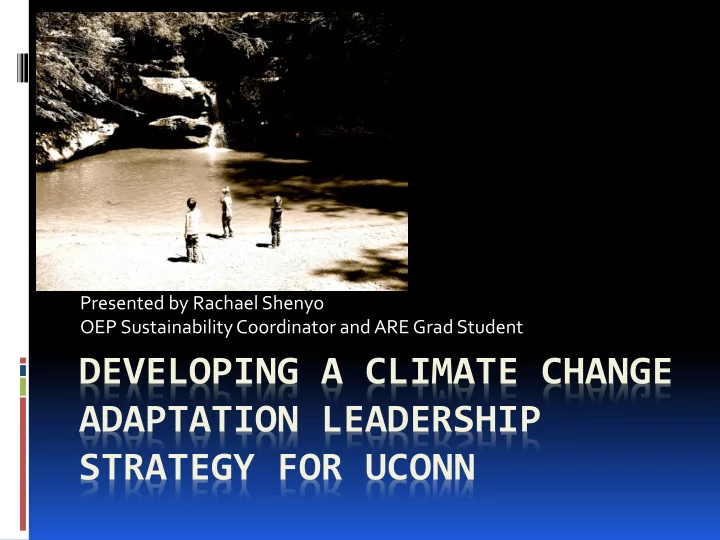

Presented by Rachael Shenyo OEP Sustainability Coordinator and ARE Grad Student DEVELOPING A CLIMATE CHANGE ADAPTATION LEADERSHIP STRATEGY FOR UCONN
Goals of presentation: Overview of reason for this discussion Overview of known regional climate challenges Existing UConn and regional expertise Short-term goals for these meetings Questions and considerations for brainstorming session … and along the way, I will be sharing some entries from the Fall 2011 Sustainable Depictions Art Competition for your enjoyment
Climate Change Adaptation: Why is the timing right for us? Renewed Presidential Commitment to CAP Previous Focus on mitigation in CAP Current events: projections vs. actual observed CO2 levels Increased demand for leadership roles in this field Opportunity to leverage UConn’s considerable diversity in expertise Chance for increased outreach to regional communities
Adaptation Vs. Mitigation: What is the difference? Mitigation has primarily dealt with local, regional, national, and international strategies for reduction of greenhouse gases correlated with global warming and subsequent climate change.
Adaptation Vs. Mitigation: What is the difference cont’d: Climate Change Adaptation is defined as the: identification of human and ecosystem risks posed by current and projected climate change impacts; and the subsequent development of local, regional, national, and international strategies to monitor the effects of climate change and mitigate or prevent associated risks and damages.
[A few] Projected and Current Climate Change Challenges for New England: Effect of Climate change: Projected to impact: Health/ agriculture/ electricity Doubling or tripling of usage annual days over 90 Flooding/ droughts/ storm degrees water/ agriculture Changing rainfall patterns Health, agriculture Increased heat/ ozone Economic impacts, water interaction table Coastal habitat and species More erratic snowfall disruptions Sea level rises Terrestrial habitat Change in forest type disruptions/ loss; agriculture
University of Connecticut Expertise: **See handouts Biodiversity and for a short Ecological list of the Adaptation kind of expertise we have at UConn, Agricultural research and and the extension kind of expertise we have in this room** Climate and impact assessment and monitoring
Goals for these meetings: Goal One: Define what Climate Change Adaptation Leadership at UConn could and should look like Leadership at local, regional, national, international level- where, what, how should we prioritize? Goal Two: Fit that definition into existing framework of University Expertise How do we leverage current diversity of experience? Goal Three: Use this information to develop a section of actionable items for the existing CAP How de we encourage and assure continued research, collaboration, outreach, and action on this theme at all levels of University leadership?
What other comparable Universities are involved in: Borrowed from Professor Anyah’s class presentation on Adaptation
Thank you for attending this important meeting today
Recommend
More recommend